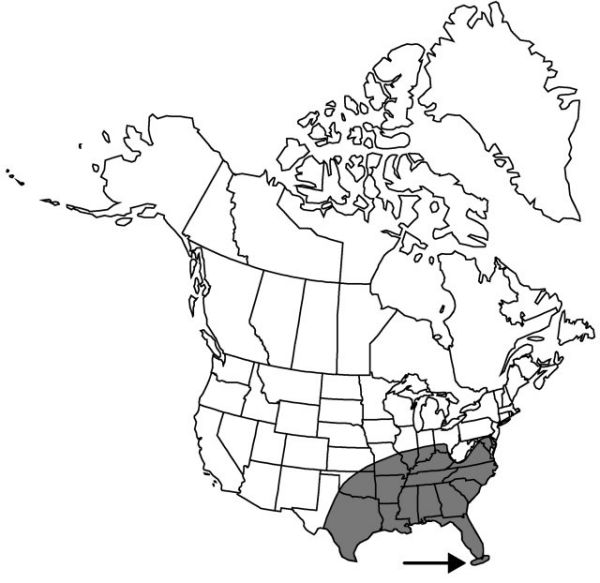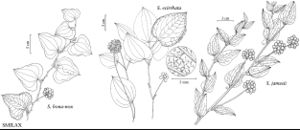Difference between revisions of "Smilax bona-nox"
Sp. Pl. 2: 1030. 1753.
FNA>Volume Importer |
FNA>Volume Importer |
||
| Line 72: | Line 72: | ||
|publication year=1753 | |publication year=1753 | ||
|special status= | |special status= | ||
| − | |source xml=https://jpend@bitbucket.org/aafc-mbb/fna-data-curation.git/src/ | + | |source xml=https://jpend@bitbucket.org/aafc-mbb/fna-data-curation.git/src/f6b125a955440c0872999024f038d74684f65921/coarse_grained_fna_xml/V26/V26_982.xml |
|genus=Smilax | |genus=Smilax | ||
|species=Smilax bona-nox | |species=Smilax bona-nox | ||
Revision as of 19:34, 24 September 2019
Vines; rhizomes tuberous, woody, or stoloniferous. Stems perennial, climbing, often zigzag distally, branched, terete to 4-angled, stout, to 5+ m × 5 mm, woody, glabrous or infrequently with stellate trichomes; prickles often absent distally, tips black, flattened, broad- based, stout, 4–9 mm, rigid. Leaves evergreen, ± evenly dispersed; petiole 0.7–1.5 cm; blade pale green, often with white blotches, drying to uniform tan, thickish, broadly ovate to lanceolate-ovate or hastate to pandurate, with 3(–5) ± prominent veins, 3–10 × 2.5–9 cm, not glaucous, glabrous or minutely pubescent abaxially, base cordate to truncate, frequently lobed; margins entire to remotely spinose-ciliate, thickened by ribbed, cartilaginous band, often revolute and appearing as prominent vein parallel to margins, apex rounded to short-apiculate. Umbels few to numerous, axillary to leaves, 10–15+-flowered, moderately dense; peduncle 1.5–6+ cm. Flowers: perianth pale green; tepals 3–4.5 mm; anthers shorter than to ± equaling filaments; ovule 1 per locule; pedicel 0.8–1.2 cm. Berries black, ovoid to spherical, 6–8 mm, shiny to dull, sometimes glaucous. 2n = 32.
Phenology: Flowering Apr–May.
Habitat: Well-drained to wet areas in woods, fields, thickets, hedgerows, floodplain forests, etc., full to partial sun
Elevation: 0–1000 m
Distribution

Ala., Ark., Del., D.C., Fla., Ga., Ill., Ind., Kans., Ky., La., Md., Miss., Mo., N.C., Ohio, Okla., S.C., Tenn., Tex., Va., Mexico, West Indies.
Discussion
Numerous varieties, based mainly on differences in leaf shape, have been proposed for Smilax bona-nox. Variation is so great even in individual plants that recognition of these varieties is untenable. J. A. Steyermark (1963) suggested that leaf variation may be correlated with stages of plant maturity. The species often may be considered weedy, occurring in very dense, tangled masses.
Selected References
None.
